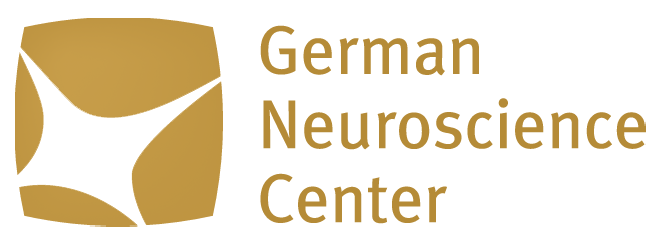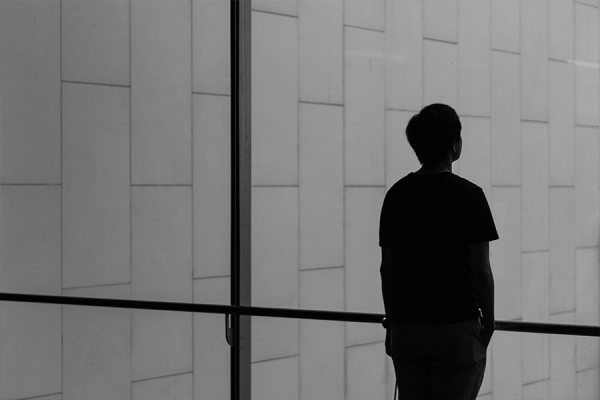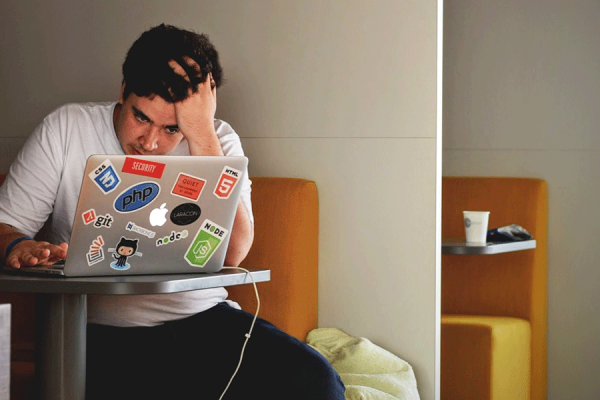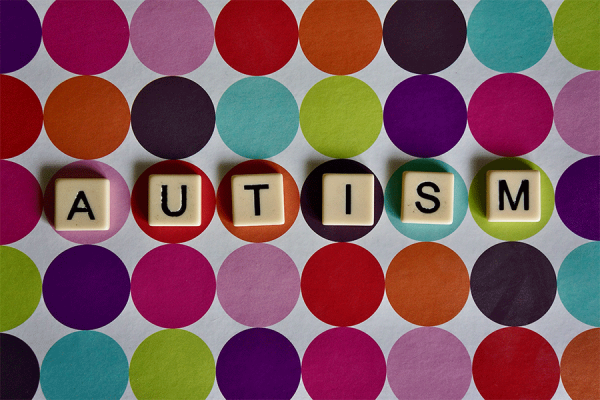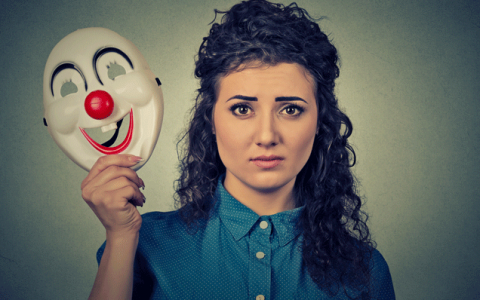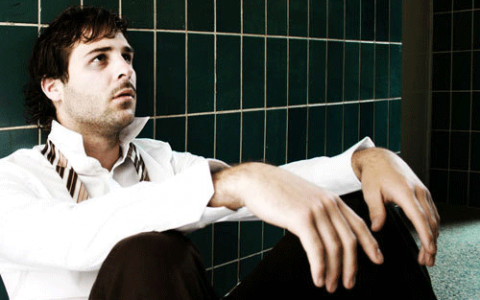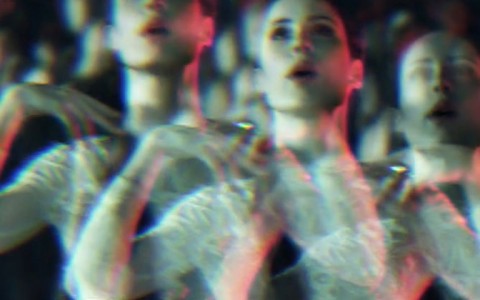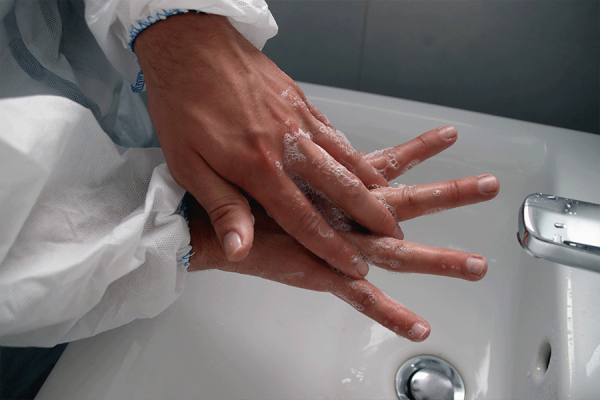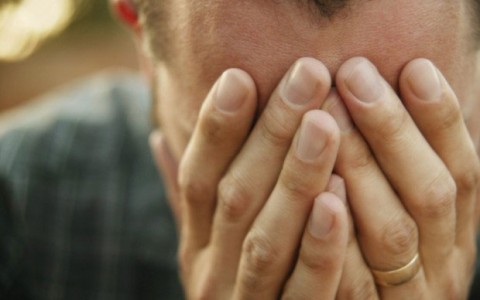Mrs. N. Kobty – Counsellor in Dubai


Profile
Dubai Counsellor
Noora is an Arab American raised in Abu Dhabi, UAE. Upon completion of her secondary education at the Choueifat International School- Abu Dhabi, she relocated to the United States to continue her studies at the Michigan State University College of Social Sciences, where she earned a Bachelor of Science degree in Psychology. Noora then completed her Post Graduate studies at Western Michigan University, where she was awarded a Masters degree in Counseling Psychology. Noora is dually licensed in the United States as both a Counselor and Psychologist by the State of Michigan and has several years of professional experience working in the United States providing a full range of Psychological Services.
She has experience working with a variety of clinical diagnosis, with a broad range of issues, from anxiety to depression to eating disorders to family issues, across all age groups from young children to elderly adults.
Noora has always had an interest in working with children. In 2010, when Noora returned to the UAE she took on a job as a School Counselor at the Glenelg School of Abu Dhabi, compassionately assisting children from 10-18 years old with various issues such as attention deficit disorder (ADD &ADHD), learning disabilities, anxiety, depression, eating disorders, family divorce, low self-esteem, peer pressure and adjustment issues. In addition, her duties involved helping children with career and academic development, as well as life skills planning. Noora is also qualified & trained to treat children through play therapy.
As a Cognitive Behavioral Therapist (CBT), who is fluent in both English & Arabic, Noora’s areas of interest working with adults include depression, anxiety, obsessive compulsive disorders, couples therapy, family dynamics, social phobia, eating disorders, paranoid thoughts, low self-esteem and adjustment difficulties.
Noora also performs various neuropsychological testing for children and adults, which include testing to determine any learning disabilities or ADHD, Personality testing and Wechsler Intelligence Scale.
© GNC, German Neuroscience Center Dubai (Neurology, Psychiatry, Psychology, Counseling, Dubai, UAE)
Articles
[vc_carousel posts_query=”size:10|order_by:date” layout=”title|link_post,image|link_post,text|excerpt,link” link_target=”_blank” speed=”2500″ mode=”horizontal” slides_per_view=”3″ autoplay=”yes” wrap=”yes” thumb_size=”medium”]© GNC, German Neuroscience Center Dubai (Neurology, Psychiatry, Psychology, Counseling, Dubai, UAE)
Diseases treated
Abuse
Abuse is a deeply concerning issue that affects individuals physically, emotionally, and psychologically. Recognizing the signs, understanding risk factors, and seeking effective treatment are vital steps towards breaking free from its grip. The German Neuroscience Center Dubai stands as a beacon of hope, offering specialized care and a multidisciplinary approach to help victims overcome abuse and reclaim their lives.Signs and Symptoms of Abuse
Abuse can manifest in various forms, leaving distinct signs and symptoms in its wake. Victims may experience unexplained injuries, frequent absences from work or social engagements, sudden changes in behavior, anxiety, depression, withdrawal, and low self-esteem. At the German Neuroscience Center Dubai, our experts are trained to recognize these signs and provide empathetic support.Risk Factors of Abuse
Certain factors can increase the likelihood of experiencing abuse. These include a history of trauma, low self-esteem, lack of social support, substance abuse, and dependence on the abuser. Recognizing these risk factors is essential for early intervention. The German Neuroscience Center's team is experienced in tailoring interventions to address individual risk factors.Causes of Abuse
Abuse can stem from a variety of underlying causes, including power dynamics, unresolved trauma, mental health issues, and learned behaviors. Understanding these root causes is crucial for creating effective treatment plans. Our clinicians at the German Neuroscience Center Dubai delve deep into the individual's history to identify these causes and devise personalized therapeutic strategies.Forms of Abuse
Abuse takes on various forms, each with its own devastating impact. This includes physical abuse, emotional and psychological abuse, sexual abuse, financial abuse, and neglect. Victims may experience a combination of these forms, leading to complex psychological distress. The German Neuroscience Center Dubai offers a comprehensive approach that addresses the multidimensional effects of abuse.Diagnostics
Accurate diagnosis is the cornerstone of effective treatment. Our specialists at the German Neuroscience Center Dubai employ a range of diagnostic tools, including comprehensive psychological assessments, interviews, and medical examinations. These assessments provide a holistic view of the individual's physical and psychological health, guiding the development of a tailored treatment plan.Treatments of Abuse
Recovery from abuse requires a multifaceted approach that integrates medical, psychological, and support interventions. The German Neuroscience Center Dubai's team of experts collaborates to create personalized treatment plans that may include psychotherapy, counseling, medication, support groups, and holistic therapies. Our commitment to holistic healing ensures that every aspect of a patient's well-being is addressed.Therapeutic Modalities
At the German Neuroscience Center Dubai, a range of evidence-based therapeutic modalities are employed to facilitate healing. Cognitive-behavioral therapy (CBT), trauma-focused therapy, dialectical behavior therapy (DBT), and art therapy are just a few of the approaches utilized. Our clinicians work closely with patients to determine the most suitable therapies for their unique needs.Support System
Recovering from abuse requires a strong support system. The German Neuroscience Center Dubai offers a safe and nurturing environment where patients can share their experiences, connect with others facing similar challenges, and access resources for ongoing healing. Our compassionate team is dedicated to empowering individuals to rebuild their lives.Conclusion
Abuse is a formidable adversary, but with the right resources and support, victims can overcome its grip and regain control of their lives. The German Neuroscience Center Dubai stands as a beacon of hope, offering comprehensive care that addresses the physical, emotional, and psychological aspects of abuse. Our experienced team is committed to guiding patients towards a path of healing, recovery, and empowerment. If you or a loved one are seeking help, reach out to the German Neuroscience Center Dubai, where compassion and expertise converge to pave the way for a brighter future.Acute reaction to Stress
Disease
Stress Disorders in Dubai: Understanding and Managing Acute Stress Reactions
Are you feeling overwhelmed, unable to cope with everyday life events, or experiencing persistent distress after a traumatic incident? You may be suffering from an acute stress disorder. At German Neuroscience Center, we specialize in providing professional help and support for individuals in Dubai who are facing stress disorders. Our dedicated team of experts is here to guide you towards a healthier, more balanced life.
Acute stress disorders can arise from extreme life events that disrupt our sense of stability and security. These events may include the loss of a loved one, experiences of violence, separation, accidents, trauma, or abuse. Sometimes, even seemingly simple occurrences like attending school or relocating can trigger a stress reaction. It is natural to feel sadness, shock, or confusion when faced with such events.
However, if your reaction persists for an extended period, becomes unmanageable, or seems disproportionate to the event itself, seeking professional help is crucial. The impact of stress disorders can manifest in various ways, such as restricted consciousness, decreased attention, disorientation, amnesia, depression, desperation, anxiety, aggression, and even physical symptoms like sweating, rapid heartbeat, and blushing.
When an acute reaction to stress occurs immediately after an event and gradually subsides, it is considered a normal response. Nonetheless, depending on the intensity of the symptoms, it may be necessary to seek professional assistance for a short period to regain control over your life.
At German Neuroscience Center, we understand the unique challenges faced by individuals in Dubai. Our team of experienced professionals specializes in stress disorders, providing comprehensive evaluations and tailored treatment plans to address your specific needs. We employ evidence-based therapeutic approaches to help you develop effective coping mechanisms, regain emotional well-being, and restore balance in your life.
Our clinic offers a welcoming and supportive environment where you can openly discuss your experiences and concerns. We prioritize your mental health and are committed to guiding you towards a brighter, healthier future. Our team utilizes a holistic approach, combining therapy, counseling, and other proven interventions to address the root causes of your stress disorders.
When you choose German Neuroscience Center, you are selecting a trusted partner dedicated to your well-being. Our expert therapists are equipped with the knowledge and experience to navigate the complexities of stress disorders, providing you with the tools necessary to overcome challenges and regain control over your life.
Don't let stress disorders hinder your happiness and quality of life. Take the first step towards healing by seeking professional help at German Neuroscience Center. Contact us today to schedule an appointment and embark on your journey to a stress-free, fulfilling life.
Remember, you don't have to face stress disorders alone. At German Neuroscience Center, we are here for you every step of the way.
Book your appointment today and start your journey towards a healthier, happier you. Let us be your partner in overcoming stress disorders in Dubai.
ADHD – Attention Deficit Hyperactivity Disorder
Disease
ADHD - Attention Deficit Hyperactivity Disorder
Approximately 5 to 10% of children between the ages of 6 and 18 years are affected by ADHD. Boys are 3 to 4 times more affected than girls. For a long time people believed that ADHD occurs solely during childhood. But in 30% of the affected children the symptoms persist – possibly in a milder form -, frequently combined with additional psychiatric disorders as depressions, anxiety disorders or dependencies. Adults with ADHD are often not diagnosed until a diagnosis has been made for one of their children.
Attention-Deficit/Hyperactivity disorder is a neurobiological brain function disorder, which often causes significant implications for the affected person’s professional and private life. It is presumed that this condition is caused by an imbalance between individual neurotransmitters leading to disturbed information processing between different areas of the brain, which are responsible for concentration, conception, and impulse control. Hence new information can be less well filtered and the persons affected become constantly over-stimulated. They are struggling to distinguish what is important from what is unimportant and is hard for them to focus on main points. Due to the high rate of occurrence within families a genetic predisposition does probably exist, but birth asphyxia and other environmental influences are said to be contributing elements, too.
ADHD Symptoms:
Attention deficiencies and disorganisation: Lack of concentration while reading longer texts – work instructions! -, difficulty following longer conversations and lectures attentively. A person with ADHD becomes even more distracted while performing subjectively boring activities, for example routine activities. New tasks are continually being started with older tasks not being finished, preventing the formation of patterns, which would be required for establishing structures. This implies disorder and chaotic organisation: The persons affected are not able to multitask, they have problems to organise their daily life and they have poor time management skills. They frequently change jobs, interrupt their life career and generally even face financial difficulties. In their private lives they are often unhappy in relationships, break up with their partners more often, have unstable friendships and have difficulties parenting their own children, too. The consequences are reduced self-esteem and feelings of failure.
Hyperactivity: is generally less pronounced in adults, but can reflect in the inability to remain seated for longer periods (flights, cinema, lectures etc.). The affected persons often jiggle feet or tap the table with their fingers.
Impulsiveness and labile affect: Emotional liability and hyperexcitability with rapidly changing moods up to several times per day may occur spontaneously but can also be initialised from the outside. The affected persons react extremely emotionally to daily stress factors; they are impatient with others, interrupt their counterpart during a conversation, are increasingly irritable, have a low frustration tolerance and tend to risky driving behaviour. On the other hand: Adults with ADHD are often very creative and have associative thinking abilities. When they are occupied with tasks they are interested in, they can work extremely hard and persistently. They even become specialists on many occasions. They are very sensitive towards interpersonal vibrations, can be very empathetic, enthusiastic and impulsive.
ADHD Treatment
There are various therapeutic options, as for example concentration techniques, self-organisation techniques and conflict management training. The treatment should be customized for each individual according to their specific needs. Moreover, education of patients, families, and teachers regarding the diagnosis is an integral part of treatment. In more severe cases medication might be required.
The treatment is focused on improvements in daily life, education, job, career, personal and family life.
© GNC, German Neuroscience Center Dubai (Neurology, Psychiatry, Psychology, Counseling, Dubai, UAE)
Adjustment Disorder
Disease
Adjustment Disorders
Adjustment Disorder means that a normal reaction to stress starts as late as a month after the event and will continue up to six months. This still would be considered a normal reaction although also in these cases therapeutic help might be necessary
© GNC, German Neuroscience Center Dubai (Neurology, Psychiatry, Psychology, Counseling, Dubai, UAE)
Anxiety, Phobia, Panic Attacks
Disease
Anxiety, Phobia, Panic Attacks, Agoraphobia, Fear
Anxiety, Phobia, Panic Attacks and Agoraphobia have one thing in common. Fear. Fear is a feeling that everybody knows as being an entirely normal feeling. Fear usually is a reaction to a frightening situation such as a bank robbery or any other dangerous situation. Normal fear turns into anxiety disorders or phobia when a fearful reaction occurs that does not correspond to the actual event, i.e. a situation that the majority of people would rate as not frightening at all, or if the anxiety reaction is so abnormally strong that the patient has the impression he is going to vomit, to faint, to die or to go insane.
Definition and Symptoms & Signs
Panic attacks
Panic attacks are unexpected short attacks of fear. The duration can be between 10 -20 minutes. The patient often experiences palpitations, chills or hot flushes, sweating, trembling or shaking, nausea, dizziness, numbness or tingling. Moreover the patients could experience shortness of breath and chest pain. This could lead to fear of having a heart attack, fear of choking, fear of losing control, fear of losing one’s mind, fear of fainting and fear of dying. Patients are not able to say what they fear in particular. Thus they are worried that it could happen again. Panic attacks can occur as panic disorder or be a symptom of other conditions like phobias or post-traumatic stress disorder.
Agoraphobia
Agoraphobia describes the fear of being trapped and not being able to escape certain situations or places while having a panic attack. These situations could be: being far from home or travelling, being in crowded places, standing in a line, being on a bridge. Thus patients are trying to avoid all these situations up to the point where they are restricted in almost all activities of daily living or even being housebound. Symptoms are sometimes less troublesome if patient is accompanied by a trusted friend or a family member
Panic disorder
We speak about panic disorder if panic attacks are recurring or if the patient is constantly worrying that another panic attack will follow. We separate panic disorder with agoraphobia from panic disorder without agoraphobia.
Associated disorders
Depression
Often patients with severe or long-lasting panic attacks / disorders develop a depression. The risk is 10 times higher than in the average population. This leads to an increased suicide attempt rate of 20%
Alcohol and substance misuse
Often patients with severe or long-lasting panic attacks / disorders develop dependencies or misuse of alcohol or other substances. The risk is 2 times higher than in the average population.
Diagnostic
It is important to exclude or rule out all organic / physical causes of the symptoms presented like a heart attack etc. Therefore it could be necessary to perform: physical examination, blood pressure, comprehensive laboratory tests, ECG, Echocardiogram, EEG, CT, MRI.
If you're unable to know what your mental health concern is, we can help you with that using our top Neurologists, psychologists & Psychiatrists help.Treatment
There are very effective ways of treatment for panic attacks / fear related disorders. Best practice is the combination of the following:
Psychotherapy
Cognitive behavioral therapy (CBT) & exposure therapy is the first-choice treatment and showed improvement in70-80% of the patients.
Medication
Antidepressants are the first-choice medication. Up to 85% of patients showed improvements. Other medications are very powerful on short term basis and are showing significant reduction of the symptoms and fear.
Lifestyle changes
Stress management programs and Support groups are a big help for patients suffering from panic disorders.
© GNC, German Neuroscience Center Dubai (Neurology, Psychiatry, Psychology, Counseling, Dubai, UAE)
Bipolar Disorder
Bipolar Disorder
Bipolar disorder, formerly known as manic-depressive disorder, is a quiet commonly used term these days. Many famous people declared to suffer from it; such as Robin Williams, Mel Gibson, Catherine Zeta-Jones, Amy Winehouse, Sinéad O'Connor, Britney Spears, Jean-Claude Van Damme, Axl Rose, Russell Brand, Richard Dreyfuss and many more. Moreover, many historical personalities are believed to have suffered from bipolar disorder; such as Frank Sinatra, Ernest Hemingway, Vincent van Gogh, Friedrich Nietzsche, Florence Nightingale, Edvard Munch, Edgar Allan Poe and many more.
Bipolar disorder seems to be a common disease that everybody knows somehow. But what are the facts? In this article we would like to give you an overview over the disease and answer the most common question.
Definition
As the name suggests, Bipolar Disorder is a mood disorder where patients can show both poles of the mood span alternating. Meaning patients could switch frequently from mania (“too happy”) to depression (“too sad”). But what is “too” happy or “too” sad? Who decides if it is a normal mood or a disease? The answer is clear. The suffering itself defines the disease. Meaning, the right question to ask should be: Is anybody suffering? The patient itself or the surrounding? If nobody is suffering it is absolute fine to be sad or happy sometimes. It belongs to life. The situation changes if somebody is suffering from its sadness or even is at the point to commit suicide because the suffering is so extreme that it appears like there is no way out. These people have the right and they should have an easy access to professional help. There should be no stigma holding them back. It’s not a weakness or failure in any kind. The same is applicable for the surrounding. If other people suffer from the behaviour of somebody else, they should have the possibility to express their suffering and search help; e.g. your spouse is so “happy” that he gambles away your whole savings because he continuously believes to be “lucky” the next time. Or a pilot who is so “happy” and over-confident that he believes that he doesn’t need sleep or any kind of safety measures anymore before flying you to your holiday destination. In these situations the patient himself won't suffer but there is a possibility that others will.
It is not a psychiatrist or any other doctor who decides in first place if somebody is mentally ill. It’s the patients themselfs and their surrounding.
Facts
Even though many successful people are suffering from bipolar disorders, it is a serious disease. Some facts: 11% to 15% of untreated patients are committing suicide. Up to 50% attempt suicide. More than 50% will develop drug or alcohol misuse. The divorce rate is increased three-fold. 50% will be unemployed 6 months after a manic episode. 800 out of 100,000 People living in the U.S. are suffering from it. Onset is most commonly between 15-24 years. Both sexes are equally affected. Bipolar disorders are more common in urban areas and in upper socioeconomic classes and higher educated people.
Causes
The causes of bipolar disorders are still unknown. Most probably there won’t be a single cause but a multifactorial genesis. The Stress-Vulnerability-Coping Model is a commonly used model to explain mental illnesses. Scientists could identify many different risk factors; like a positive family history of bipolar disorder. Patients whose father or mother suffered from bipolar disorder have a 20% higher risk to develop it as well. Moreover childbirth was discovered as a risk factor. 45% of women suffering from bipolar disorder had their first episode in the postpartum period. Stress - be it physical (eg physical illnesses) or psychological (eg work, relationship etc.) - seems to be a risk factor; as well as drug or alcohol abuse.
Symptoms and signs
Depression: The ICD-10 defines 3 major symptoms which are depressed mood, Loss of pleasure and interest in activities and Fatigue or loss of energy. Other symptoms could be lack of concentration and memory, hopelessness, feelings of guilt and unworthiness, suicidal tendencies, sleep disorders, loss of appetite and weight.
Mania: The ICD-10 defines 2 major symptoms which are abnormally euphoric mood or irritated mood. Further symptoms could be lack of concentration and distractibility, racing thoughts, poor judgment, reckless behavior, increased impulsivity, inflated self-esteem, increased energy, increased activity, hyperactivity, rapid speech, reduced need for sleep, increased libido and hyper sexuality.
Psychotic symptoms: in both episodes it is possible that psychotic symptoms occur.
Forms
Bipolar I disorder is described as the combination of 2 or more episodes of Mania and Depression or mixed episodes.
Bipolar II disorder is described as the combination of 2 or more episodes of Hypomania and Depression or mixed episodes.
Rapid cycling bipolar disorder is described as the combination of 4 or more episodes of Mania and Depression or mixed episodes in one year.
Ultra rapid cycling bipolar disorder is described as the combination of 4 or more episodes of Mania and Depression or mixed episodes in one month.
Diagnosis
As in any mental illness first severe organic causes have to be ruled out. This should be done by a psychiatrist and include physical examination, blood tests and the MRI of the brain should not be older than 1 year. If medication should be used other diagnostic procedures may be applicable like EEG or ECG. In the second step the psychiatrist will do psychiatric examination and evaluate based on the ICD-10 or the DSM-IV the symptoms. Moreover there are neuropsychological tests available to evaluate the symptoms of manic or depressive episodes under the supervision of our top Neurologists in Dubai.
Treatment

There are very effective treatment options for bipolar disorders. The priority is to protect the patient and his surrounding from any kind of risk. Be it the sufferer itself from risky behaviour or suicide; be it his surrounding from reckless behaviour or abuse. Without adequate treatment the average woman suffering from bipolar disorder will lose 9 years of life, 14 years of effective activity, and 12 years of normal health. This is due to the fact that bipolar disorder is a chronic disease. Over 90% of people who have an episode of mania will have another. The earlier the onset, the worse is the prognosis. With treatment 90% will improve, 50% will be symptom-free.
But before going into detail, let’s have a look at the biggest obstacles on the way to get there.
Therapy motivation. The most complicated step is always the first one. Searching professional help is a difficult step for most people. It seems that the stigma of mental illnesses is widely present. Moreover the inside that treatment could be necessary is particularly in manic episodes often not sufficient. Even if the surrounding is suffering from the behaviour of the patient, the patient in a manic episode could not be aware of it. It is a difficult task for caregivers to convince the patient that there might be something wrong. Often the patients realize the consequences of their behaviour only after the manic episode is over or if it has severe consequences like jail terms or health damages. While suffering from a depressive episode the drive is often reduced to the extent that patients are not able to search for help by them self’s. This shows the importance’s of the caregivers in bipolar disorders.
The next obstacle is the maintenance of a successful therapy. Even if the patient discovered that treatment helped, it is common that they will stop medication at some point. One-third to one-half of bipolar patients stop medication against advice. As bipolar disorder is highly recurring, there is a high risk of relapse.
Pharmacotherapy
In Bipolar disorder different types of medication are used. The treatment is always individual and depends on many factors, such as experienced effects in the past, side effects, current episode, severity of symptoms etc. Commonly used medications are Mood Stabilizer, Antidepressants, Anticonvulsants and Benzodiazepines. An average treatment period could be 12 month in patients with a low risk of relapse and 5 years to indefinite in patients with high risk of relapse.
Psychology
Medication should always be combined with some kind of psychological support. It is important to establish a reliable relationship to your healthcare professional and to develop a realistic treatment plan. It could include Cognitive behavioral therapy, Family therapy or group therapy.
Psychoeducation
Particularly in bipolar disorder the knowledge about the disease is essential. For patients and caregivers as well. It’s important to identify individual risk factors and triggers and to develop strategies to avoid them. Moreover the patient has to learn to detect early symptoms of another episode.
Lifestyle
The goal is to eliminate all individual risk factors that could trigger a relapse. This could include sleep pattern, substance use, stress at work or in the family. It could be shown that a relapse is less likely if a good sleep pattern is maintained.
Support groups
To have a good psychiatrist and a professional health support is important. However, besides this it is big help to get help from other sufferers or caregivers as well. Here you can find more information about our free of charge support group.
Video
References
- Poolsup N, Li Wan Po A, de Oliveira IR. Systematic overview of treatment in acute mania. J Clin Pharm Ther. 2000;25:139-56
- Macritchie K, Geddes JR, Scott J, et al. V for acute mood episodes in bipolar disorder. Cochrane Database Syst Rev. 2003:CD4052
- Davis JM, Janicak PG, Hogan DM. M in the prevention of recurrent affective disorders: a meta-analysis. Acta Psychiatr Scand. 1999;100:406-17
- Donna Sudak, MD
- Tondo L, Hennen J, Baldessarini RJ. Lower suicide risk with long-term L treatment in major affective illness: a meta-analysis. Acta Psychiatr Scand. 2001;104:163-72
- Geddes JR, Burgess S, Hawton K, et al. Long-term L therapy for bipolar disorder: systematic review and meta-analysis of randomized controlled trials. Am J Psychiatry. 2004;161:217-22
- Goodwin GM, Bowden CL, Calabrese JR, et al. A pooled analysis of 2 placebo-controlled 18-month trials of L and L maintenance in bipolar I disorder. J Clin Psychiatry. 2004;65:432-41
- Macritchie KA, Geddes JR, Scott J, et al. V acid, V and D in the maintenance treatment of bipolar disorder. Cochrane Database Syst Rev. 2001:CD3196
- Ceron-Litvoc D, Soares BG, Geddes J, et al. Comparison of C and L in treatment of bipolar disorder: a systematic review of randomized controlled trials. Hum Psychopharmacol. 2009;24:19-28
- Rendell JM, Gijsman HJ, Keck P, et al. O alone or in combination for acute mania. Cochrane Database Syst Rev. 2003:CD4040
- Yatham LN, Grossman F, Augustyns I, et al. Mood stabilisers plus r or placebo in the treatment of acute mania: international double-blind, randomised controlled trials. [Erratum in Br J Psychiatry 2003;182:369] Br J Psychiatry. 2003;182:141-7
- Rendell JM, Gijsman HJ, Bauer MS, et al. R alone or in combination for acute mania. Cochrane Database Syst Rev. 2006:CD4043
- Lenox RH, Newhouse PA, Creelman WL, Whitaker TM. Adjunctive treatment of manic agitation with L versus H : a double-blind study. J Clin Psychiatry. 1992;53:47-52
- Meehan K, Zhang F, David S, et al. A double-blind, randomized comparison of the efficacy and safety of intramuscular injections of O , L or placebo in treating acutely agitated patients diagnosed with bipolar mania. J Clin Psychopharmacol. 2001;21:389-97
- Gijsman HJ, Geddes JR, Rendell JM, et al. A for bipolar depression: a systematic review of randomized controlled trials. Am J Psychiatry. 2004;161:1537-47
- Nolen WA, Bloemkolk D. Treatment of bipolar depression: a review of the literature and a suggestion for an algorithm. Neuropsychobiology. 2000;42:11-17
- Delbello MP, Schwiers ML, Rosenberg HL, Strakowski SM. A double-blind, randomized, placebo-controlled study of Q as adjunctive treatment for adolescent mania. J Am Acad Child Adolesc Psychiatry. 2002;41:1216-23
- Derry S, Moore RA. Atypical A in bipolar disorder: systematic review of randomised trials. BMC Psychiatry. 2007;7:40
- Geddes JR, Calabrese JF, Goodwin GM. L for treatment of bipolar depression: independent meta-analysis and meta-regression of individual patient data from five randomised trials. Brit J Psychiatry. 2009:194:4-9
- Scott J, Garland A, Moorhead S. A pilot study of cognitive therapy in bipolar disorders. Psychol Med. 2001;31:459-67
- Beynon S, Soares-Weiser K, Woolacott N, et al. Psychosocial interventions for the prevention of relapse in bipolar disorder: a systematic review of controlled trials. Brit J Psychiatry 2008;192:5-11
- Miklowitz DJ, George EL, Richards JA, et al. A randomized study of family-focused psychoeducation and pharmacotherapy in the outpatient management of bipolar disorder. Arch Gen Psychiatry. 2003;60:904-12
- Rea MM, Tompson MC, Miklowitz DJ, et al. Family-focused treatment versus individual treatment for bipolar disorder: results of a randomized clinical trial. J Consult Clin Psychol. 2003;71:482-92
- Colom F, Vieta E, Martinez-Aran A, et al. A randomized trial on the efficacy of group psychoeducation in the prophylaxis of recurrences in bipolar patients whose disease is in remission. Arch Gen Psychiatry 2003;60:402-7
- Perry A, Tarrier N, Morriss R, et al. Randomised controlled trial of efficacy of teaching patients with bipolar disorder to identify early symptoms of relapse and obtain treatment. BMJ 1999;318:749-63
Child & Adolescent Mental Health
Trigeminal Neuralgia
Trigeminal neuralgia is a special case of nerve pain. It is often described as the “the world’s worst pain.” Typically, patients suffer from attacks of intense, electric shock-like facial pain along the trigeminal nerve.
Causes & Risk factors
Although the exact cause of trigeminal neuralgia is not fully understood, research indicates that the trigeminal nerve is damaged by a loss of myelin, in some cases caused by a blood vessel compressing the nerve. Other causes include multiple sclerosis, stroke, brain trauma and others.
Symptoms
Trigeminal neuralgia patients suffer from attacks of intense, electric shock-like facial pain along the trigeminal nerve. These attacks can occur without warning signs and last from seconds to minutes. In some cases, they might be trigger by touching the face, talking, eating, drinking, shaving or brushing teeth and other activities.
Diagnosis
In case of trigeminal neuralgia, most important is a consultation with an experienced Neurologist. The clinical impression and physical examination are guiding the way. If the location is identified, certain nerve tests like Nerve Conducting Velocity or Electromyography may be used to verify the diagnosis or to determine the location precisely.
Treatment
First line treatment for Trigeminal neuralgia are certain medications such as anticonvulsants, antidepressants, injections etc. Usually, those have a good response rate over 85%. Only in cases of remaining pain surgery should be considered. There are various types of surgery available nowadays. Most surgeries are leading to a complete destruction of the nerve, which causes facial numbness. Therefore, surgery should be only considered if all other treatment options failed.
Our Team Of Experts
Since more than ten years GNC is the leading clinic for Neurology in the UAE. All our Trigeminal Neuralgia experts are German Board Certified and have minimum professional experience of 25 years. If you are searching for the most trusted Trigeminal Neuralgia experts, you came to the right place.
We can also help you with the best psychologist, psychiatrist and psychotherapist available in Dubai, UAE.Testimonials
``The doctor is the best and everyone's very helpful``
``Excellent doctor``
``I am thankful for the service.``
``Being able to have blood tests and EEG done at the clinic itself was very helpful and convenient. This also allowed my doctor to have fast access to the test results.``
``I'm impressed by the Professor and team professionalism``
``God bless you guys wish you more of success``
``Great service``
``It was a great visit thanks! It really helped me.``
As Seen On


Depression
Disease
Depression
Depression – a disorder as old as the history of humankind. Already Hippocrates (460-377 BC) described melancholia, a condition very similar to today’s depression.
More than 350 million people globally are affected by depression and it can affect anyone – from young people to seniors. But what exactly means being affected by a depression? What are the common symptoms? And which treatments are available?
Definition
Depression is a serious medical illness that causes a persistent feeling of sadness and/or loss of interest. It is also called major depression, major depressive disorder or clinical depression and it affects your feelings, your way of thinking and how you behave. A Depression can lead to a variety of emotional and physical problems, it may make you feel as if life isn't worth living and often it interferes in doing your normal day-to-day activities.
Symptoms
Symptoms can include sadness, emptiness, a loss of interest or pleasure in activities you used to enjoy, a change in weight, a difficulty sleeping or oversleeping, an energy loss, anxiety, agitation or restlessness, slowed thinking, speaking or body movements, feelings of worthlessness and thoughts of death or suicide.
Forms
There are several forms of depression. One distinguishes between a Major Depressive Disorder, Persistent Depressive Disorder (Dysthymia), Psychotic Depression, Postpartum Depression and Seasonal Affective Disorder (SAD).
- Major Depressive Disorder: This form is characterized by a depressed mood which lasts for more than two weeks and which impairs the patient’s life, including work, private life, relationships and friendships. An episode can occur only once in a person’s lifetime, but more often, a person has several episodes.
- Persistent Depressive Disorder (Dysthymia): This form lasts for at least two years and the patient may have episodes of a major depression along with periods of less severe symptoms. This is considered a chronic form of depression.
- Psychotic Depression: This form occurs when a patient has severe depression plus some form of psychosis, such as having disturbing false beliefs or a break with reality (delusions), or hearing or seeing upsetting things that others cannot hear or see (hallucinations).
- Postpartum Depression: This form many women experience after giving birth when hormonal and physical changes and the new responsibility of caring for a newborn can be overwhelming. It is more serious than the “baby blues”.
- Seasonal Affective Disorder: This form is characterized by the symptoms of a Major Depressive Disorder only during a specific time of year, usually winter. This appears to be related to the shorter days of winter, and the lack of sunlight in many parts of the country.
A depression is more than just a “blues” or feeling down for a few days. It is a medical illness, not a sign of weakness.
Causes
There are a number of factors that may increase the chance of depression but it is not known exactly was causes this illness. Factors that could be involved are biological differences, brain chemistry, hormones, inherited traits and life events. Most likely, depression is caused by a combination of these factors. It is supposed by longstanding theories about depression that important neurotransmitters - chemicals that brain cells use to communicate - are out of balance. Brain-imaging technologies, such as magnetic resonance imaging (MRI), have shown that the brains of people who have depression look different than those of people without depression. The parts of the brain involved in mood, thinking, sleep, appetite, and behavior appear different.
Moreover, the risk for depression could result from the influence of several genes acting together with environmental or other factors as research indicates. In addition, trauma, loss of a loved one, a difficult relationship, or any stressful situation may trigger a depressive episode. Other depressive episodes may occur with or without an obvious trigger.
Treatment
A comprehensive physical examination by a doctor should be the first step of getting a treatment to rule out other possible causes for the symptoms. Next a diagnostic evaluation for depression should be conducted by a Psychiatrist or a mental health professional. The treatment depends on the type of depression that you may be suffering from. For example, some patients with a clinical depression are treated with psychotherapy and others are prescribed antidepressants. Still others who don't respond to standard depression treatments are treated by brain stimulation techniques such as electroconvulsive therapy (ECT), also called electroshock therapy, transcranial magnetic stimulation (TMS), or vagus nerve stimulation (VNS).
However, you should be aware that depression will not be cured in only one day or with only one pill. Being patient is important and trying different antidepressant may be required to find the most effective one for you. Psychotherapy is an effective treatment but on its own it may not be enough to resolve severe depression. But it can play an important role when used with other treatments, including medications.
If you're unable to know what your mental health concer is, we can help you with that using our top Neurologists & psychologists help.© GNC, German Neuroscience Center Dubai (Neurology, Psychiatry, Psychology, Counseling, Dubai, UAE)
Dissociative Disorder (Conversions)
Disease
Dissociative Disorder (Conversions)
Definition of Dissociative Disorder
Traumatic events or seemingly unsolvable problems can lead to psychic reaction known as dissociative disorder. It is characterized by a disconnection and lack of continuity between thoughts, memories, surroundings, actions and identity. People with a dissociative disorder experience their body or the world around them as unreal and they are uncertain about who they are. They could feel like having many different identities which often leads to problems with functioning in everyday life. They may escape reality in ways that are involuntary and unhealthy.
Symptoms
Signs and symptoms of dissociative disorder could include memory loss (amnesia) of certain time periods, events and people, an inability to recall key personal information that is too far-reaching to be explained as mere forgetfulness, a sense of being detached from yourself and a blurred sense of identity. Along with the dissociation and multiple or split personalities people may also experience depression, mood swings, sleep disorder, anxiety, panic attacks, eating disorders and more.
Dissociative disorder is separated into three major disorders:
1. Dissociative amnesia: People with this disorder are blocking out critical personal information, usually of a traumatic or stressful nature. They can't recall information about themselves or events and people in their life, especially from a traumatic time. These gaps in memory are much more severe than normal forgetfulness, and are not the result of an underlying medical condition.
2. Dissociative identity disorder: This disorder is characterized by alternate identities. People may feel the presence of one or more other people talking or living inside their head and a feeling as though they are possessed by other identities. This disorder was formerly known as multiple personality disorder and it is the most famous of the dissociative disorders. People with dissociative identity disorder typically also have dissociative amnesia and often have dissociative fugue.
3. Depersonalization-derealization disorder: People with this disorder experience a feeling of being outside themselves. They observe their actions, feelings and thoughts from a distance as though watching a movie. A person with depersonalization disorder has this experience so frequently and so severely that it interrupts his or her functioning and experience.
Causes
The main causes for dissociative disorder are traumatic events in the past such as physical, sexual or emotional abuse suffered during childhood, although some people 'dissociate' after experiencing war, kidnapping or even an invasive medical procedure. Switching off from reality is a normal defense mechanism to cope during a traumatic time but it becomes dysfunctional when the environment is no longer traumatic but the person still acts and lives as if it is.
Treatment
The primary treatment for dissociative disorder is psychotherapy. The psychotherapist consultation will help the patient to understand the cause of the condition and to form new ways of coping with stressful circumstances. A person with dissociative disorder might also benefit from drugs such as antidepressants or antianxiety medication. These medications can help to control the mental health symptoms associated with dissociative disorders.
© GNC, German Neuroscience Center Dubai (Neurology, Psychiatry, Psychology, Counseling, Dubai, UAE)
Eating Disorders
Disease
Eating Disorders, Bulimia nervosa, Anorexia nervosa
What are Eating Disorders?
Eating Disorders are conditions defined by abnormal eating habits that may involve either insufficient or excessive food intake to the detriment of an individual’s physical and mental health. Bulimia nervosa, anorexia nervosa and binge-eating disorder are the most common specific forms of eating disorders.
Eating disorders can cause serious physical problems and they can even be life-threatening. Most commonly they appear during the teen years or young adulthood but may also develop during childhood or later in life.
Types and Symptoms
Anorexia nervosa
Anorexia nervosa is characterized by abnormal eating behavior, an obsession with food and being thin, sometimes to the point of deadly self-starvation. A person with Anorexia has an intense fear of gaining weight, a distorted body image, a self-esteem that is heavily influenced by perceptions of body weight and shape, or a denial of the seriousness of low body weight. Even if a patient is underweight he sees himself as overweight. Moreover, the disease is characterized by a refusal to eat and denial of hunger, excessive exercise and a fear of eating in public.
Physical consequences of Anorexia nervosa could include the thinning of the bones (osteopenia or osteoporosis), brittle hair and nails, dry and yellowish skin, growth of fine hair all over the body (lanugo), low blood pressure, slowed breathing and pulse, damage to the structure and function of the heart, brain damage, multiorgan failure and infertility.
Bulimia nervosa
Bulimia nervosa is characterized by episodes of eating large amounts of food in a short duration followed by forced vomiting, excessive use of laxatives or diuretics, fasting, excessive exercise, or a combination of these behaviors. People with this disease may be at a normal weight or even a bit overweight, although they often fear gaining weight, desperately want to lose weight and intensely are unhappy with their body size and shape.
Physical consequences of Bulimia nervosa could include a chronically inflamed and sore throat, swollen salivary glands in the neck and jaw area, abnormal bowel functioning, damaged teeth and gums, irregular heartbeat, menstrual irregularities or loss of menstruation and an electrolyte imbalance which can lead to heart attack.
Binge-eating disorder
People with Binge-eating disorder lose control over eating. They eat excessive amounts of food (binge), but unlike Anorexia and Bulimia they don't try to compensate for this behavior with exercise, fasting or purging. Binge-eating disorder is characterized by eating to the point of discomfort or pain, eating faster and frequently eating alone.
As a result, people with binge-eating disorder often are over-weight or obese. They are at a higher risk for developing cardiovascular disease and high blood pressure. Moreover, people with this disease often feel depressed, disgusted or upset over the amount eaten. They experience guilt, shame, and distress about their binge-eating, which can lead to more binge-eating.
Causes
The causes for eating disorders are manifold. Possible causes include biological reasons, psychological and mental health and society. There may be genes that make certain people more vulnerable to developing eating disorders. People with these disorders may have psychological and emotional problems such as a low self-esteem that contribute to the disorder. Moreover, society often cultivates a desire for thinness, especially in the modern Western culture.
Treatment
Psychotherapy, nutrition education and medication are effective treatment methods for eating disorders. An individual, group or family psychotherapy helps the patient to learn how to exchange unhealthy habits for healthy ones. The main focus of the treatment is to restore the person to healthy weight, treating the psychological issues related to the eating disorder and to reduce or eliminate behaviors or thoughts that lead to insufficient eating and preventing relapse. Cognitive behavioral therapy is commonly used in eating disorder treatment, especially for bulimia nervosa and binge-eating disorder.
Eating disorders can’t be cured by medications but they may help to control urges to binge or purge or to manage excessive preoccupations with food and diet. Since eating disorders often occur along with depression and anxiety medications such as antidepressants, anti-anxiety and mood stabilizers may also help with these symptoms.
© GNC, German Neuroscience Center Dubai (Neurology, Psychiatry, Psychology, Counseling, Dubai, UAE)
Obsessive-Compulsive Disorder (OCD)
Obsessive-Compulsive Disorder (OCD) is a complex mental health condition that affects millions of people worldwide. Characterized by persistent and distressing thoughts (obsessions) and repetitive behaviors (compulsions), OCD can significantly disrupt an individual's daily life, causing distress and anxiety. If you or a loved one is struggling with OCD, rest assured that the German Neuroscience Center in Dubai is dedicated to providing comprehensive and specialized care to help you overcome these challenges.Symptoms of Obsessive-Compulsive Disorder (OCD)
OCD manifests through a wide range of symptoms, often involving intrusive thoughts and the need to perform certain behaviors to alleviate anxiety. Common obsessions include fear of contamination, concerns about harming oneself or others, and an overwhelming need for symmetry and order. Compulsions, on the other hand, might involve repetitive actions like washing hands, checking locks, or counting objects to neutralize the distress caused by the obsessions.Risk Factors for Obsessive-Compulsive Disorder (OCD)
While the exact cause of OCD remains unclear, several risk factors have been identified:- Genetics: Family history of OCD can increase the likelihood of developing the disorder.
- Brain Structure and Function: Certain brain abnormalities or imbalances in neurotransmitters may contribute to OCD.
- Trauma: Childhood trauma or significant life stressors can trigger the onset of OCD in susceptible individuals.
- Personality Traits: Perfectionism, high levels of anxiety, and a propensity for excessive worry can increase vulnerability.
Causes of Obsessive-Compulsive Disorder (OCD)
The development of OCD is likely influenced by a combination of genetic, neurological, and environmental factors. Research suggests that an interplay between genetic predisposition and brain chemistry plays a crucial role. Abnormalities in the brain's circuitry involving the basal ganglia and frontal cortex are thought to contribute to the disorder's symptoms.Diagnosis of Obsessive-Compulsive Disorder (OCD)
Diagnosing OCD involves a thorough assessment of an individual's symptoms and their impact on daily functioning. A skilled mental health professional at German Neuroscience Center Dubai will conduct a comprehensive evaluation, which may include interviews, psychological questionnaires, and discussions about the history and duration of symptoms. This meticulous process ensures an accurate diagnosis and a personalized treatment plan.Treatments for Obsessive-Compulsive Disorder (OCD)
At German Neuroscience Center Dubai, a multidisciplinary approach is employed to provide the most effective treatments for OCD:- Cognitive-Behavioral Therapy (CBT): CBT, particularly Exposure and Response Prevention (ERP), is a gold-standard psychotherapy for OCD. It involves gradual exposure to feared situations or thoughts and learning healthier ways to manage anxiety without resorting to compulsions.
- Medication: Selective Serotonin Reuptake Inhibitors (SSRIs) are commonly prescribed to manage OCD symptoms. These medications help regulate neurotransmitter levels in the brain and can be especially beneficial when combined with therapy.
- Deep Transcranial Magnetic Stimulation (dTMS): This innovative non-invasive procedure utilizes magnetic fields to stimulate specific brain areas, helping to modulate neural circuits associated with OCD symptoms.
- Support Groups and Education: Engaging in support groups and receiving education about OCD can help individuals and their families better understand the disorder and cope effectively.
Why Choose German Neuroscience Center Dubai for OCD Treatment
German Neuroscience Center Dubai stands out as a leading institution for OCD treatment due to its commitment to providing patient-centered care:- Expertise: The center boasts a team of experienced psychiatrists, psychologists, and therapists with a deep understanding of OCD and its complexities.
- Tailored Treatment Plans: Each patient receives a personalized treatment plan based on their unique needs and preferences, ensuring the highest chances of success.
- Cutting-Edge Therapies: The center offers a wide range of evidence-based treatments, including CBT, medication, and advanced therapies like dTMS.
- Holistic Approach: The team at German Neuroscience Center Dubai recognizes the importance of addressing both the psychological and emotional aspects of OCD, promoting overall well-being.
Conclusion
Obsessive-Compulsive Disorder can be a challenging condition to manage, but with the right support and treatment, individuals can regain control over their lives. German Neuroscience Center Dubai is dedicated to providing the highest quality care for individuals struggling with OCD. Through a combination of expert knowledge, personalized treatment plans, and advanced therapies, the center is committed to helping patients overcome the grip of OCD and embrace a healthier, more fulfilling life.PTSD – Post Traumatic Stress Disorder
Disease
PTSD: Post Traumatic Stress Disorder Symptoms, Treatment & More
.
What is Post traumatic stress disorder (PTSD)?
Post-traumatic stress disorder - PTSD - is a serious mental health condition that occurs after a traumatic event. PTSD is a lasting consequence of traumatic ordeals that cause intense fear, helplessness, or horror. It could remain for month or even years. It could start directly after the event or delayed by months. After experiencing or witnessing a terrifying event a person may have difficulties coping and adjusting it. The person may feel stressed or frightened even when he is no longer in danger. These feelings continue and even increase, becoming so strong that they keep the person from living a normal life.
Symptoms
Post-traumatic stress disorder (PTSD) could include many symptoms. Most often they begin within three month of the traumatic event. There are three main categories of PTSD Symptoms:
- Reliving: The person with post-traumatic stress disorder repeatedly relives the traumatic event as if it were happening again. This may include flashbacks, nightmares and hallucinations. He or she also may feel severe emotional distress or physical reactions to something that reminds him of the event.
- Avoiding: The person avoids thinking or talking about the traumatic event. He or she may also avoid places, events or objects that reminds him or her of the trauma which can lead to feelings of detachment and isolation. A strong guilty feeling and depression may occur.
- Increased arousal: The person may feel tense, frightened and easily startled. He or she may experience troubles of sleeping and concentrating as well as irritability or outbursts of anger. Physical symptoms, such as increased blood pressure and heart rate, rapid breathing, muscle tension, nausea, and diarrhea also may occur.
Moreover the person could feel depressed or emotional numb. Sometimes the patients block the event completely from their memory.
Causes
A person suffering from PTSD can develop a post-traumatic stress disorder when he or she goes through or witnesses a traumatic event, such as sexual violation, torture, child abuse, car accidents, sudden death of a loved one or a natural disaster. PTSD can occur in anyone who has experienced a traumatic event but it is assumed that it is caused by a mix of the brain regulation of stress chemicals and hormones and inherited mental health risks, such as an increased risk of anxiety and depression. Moreover, life experiences and inherited aspects of the personality do play a big role.
If you're unable to know what your mental health concern is, we can help you with that using our top Neurology Doctor, Psychiatry Doctor, and Psychology doctor's help.
Treatment
The treatment of PTSD is very effective. The goal is to support the coping skills of the patient to be able to deal with the traumatic event. The main treatments for people with post-traumatic stress disorder are psychotherapy or medications, sometimes both. The patient will learn certain skills to address the symptoms and thus improve the symptoms. The Psychologist helps in coping if any symptoms arise again.
Cognitive behavioral therapy (CBT) is a very helpful therapy when suffering from PTSD. There are several parts to CBT, including:
- Exposure therapy: It helps facing and controlling the fear by mental imagery, writing, or visiting the place where the event happened.
- Cognitive restructuring: It helps recognizing the way of thinking such as negative or inaccurate ways of perceiving normal situations. Sometimes people remember the event differently than how it happened. The Psychologist helps looking at things in a realistic way.
- Stress inoculation training: It helps reducing the symptoms by reducing anxiety. It helps looking at the memories in a healthy and realistic way.
All these approaches can help reducing fear after a traumatic event. The best type of treatment should be discussed individually with the Psychologist. Moreover, certain medications, such as Antidepressants and Anti-anxiety medications, can improve the feelings of anxiety and stress. Sometimes a combination of psychotherapy and medications is recommended by the Specialist.
Furthermore the PTSD patient will learn relaxation techniques such as PMR or autogenic training. It is recommended that the patient visits a support group as well to learn from other sufferers how they managed the situation.
© GNC, German Neuroscience Center Dubai (Neurology, Psychiatry, Psychology, Counseling, Dubai, UAE)
Schizophrenia
What is Schizophrenia?
Schizophrenia is a brain disorder. It affects the way a person acts, thinks and sees the world. Often people with schizophrenia have different perception of reality and even lose contact with reality. They might see things, that others do not see or might hear voices that others do not hear (hallucinations). They might even speak in a confusing way or might believe in their own „reality“(delusion). Even some people feel persecuted or constantly watched (paranoia). Others have a disorganized behaviour or so-called „negative symptoms“, such as lack of emotional expressions or lack of enthusiasm. If a person shows symptoms as a radical change in personality and an impaired functioning plus a distorted or non-existent sense of reality we speak in medical terms of „psychosis“.
Schizophrenia typically begins in the early adulthood, between the age of 15 and 25. Women tend to develop first symptoms several years later than men, typically around the age of 25. However, men are more affected than women. Symptoms might develop slowly or sometimes it shows the full syndrome immediately. Early warning signs of schizophrenia could be a social withdrawal, depression, suspiciousness or inappropriate laugh or crying. It is important to be aware of early symptoms, because the earlier the disorder is diagnosed the better it can be treated.
Schizophrenia is affecting approximately 0.7 to 1.0 percent of the adult population worldwide. About 26 million people worldwide are affected by schizophrenia. We would therefore estimate to have about 50'000 people suffering from schizophrenia in the UAE.
While schizophrenia is among the common mental disorders, anxiety and mood disorders such as depression are 5 to 10 times more frequent. In the past years there was a longstanding opinion that the prevalence of schizophrenia varied little from population to population. Today we have indications that the rates of schizophrenia can vary in different regions due to the influence of cultural, urban and geographic factors. For example migrants have higher prevalence’s then native-born individuals and developed countries higher prevalence’s then non-developed countries. The highest prevalence is among people with low socioeconomic status living in developing nations. Recent studies suggest that environmental factors related to urban residence may contribute to development of schizophrenia.
The WHO published data 2002 regarding the prevalence of schizophrenia and we know, that the disorder tends to be the highest in Oceania and Middle East and Asia compared to Australia, Japan and Europe.
Symptoms and Signs
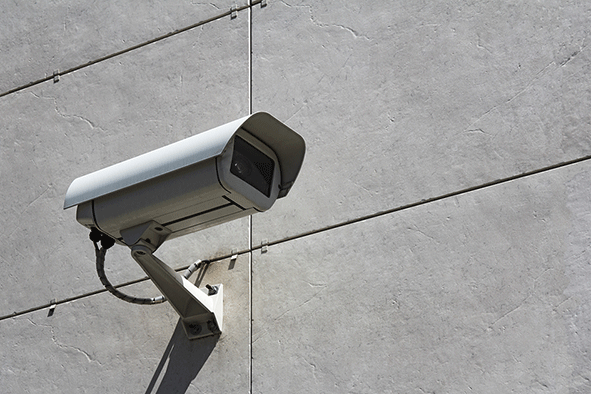 There are two kinds of symptoms – early symptoms which may exist years before the actual outbreak of Schizophrenia - and main symptoms. The early symptoms include the alteration of experience and conspicuousness in conduct although to a small extent that it will not easily be brought into connection with early signs of schizophrenia.
There are two kinds of symptoms – early symptoms which may exist years before the actual outbreak of Schizophrenia - and main symptoms. The early symptoms include the alteration of experience and conspicuousness in conduct although to a small extent that it will not easily be brought into connection with early signs of schizophrenia.The main symptoms of Schizophrenia are Delusions, Hallucinations, disorganized speech, disorganized behavior and negative symptoms like diminished emotional expression or avolition. These symptoms mark the active phase of the disorder which emerges after a stressor or substance abuse or without any identifiable stressor. Patients often suffer from social disorders due to a loss of personal abilities such as initiative, interest, and pleasure in life and other people. Their emotions may be blunted and there may be a poverty of speech and diminished activity and self-care. Moreover Schizophrenia often affects cognitive areas such as memory and attention. A lack of decision-making capability is common, especially in older patients.
Causes
Today the causes of schizophrenia are not fully known. It appears to be a result of a complex interaction between genetic (hereditary) and environmental factors. Schizophrenia has a strong hereditary component, which means, that individuals with a first-degree relative who has schizophrenia have a 10 percent chance to develop the disorder, so an approximately 15 times higher risk than the average population.
But it is important to mention, that the disorder is only influenced, not determined by genetics. So we know that the inherited genes make a person vulnerable to get schizophrenia, but the environmental factors act on the vulnerability and trigger the onset of the disorder. From research we know, that „stress-inducing“factors might be involved in schizophrenia, such as prolonged birth, malnutrition before birth or prenatal exposure to a viral infection. Problems with certain naturally occurring brain chemicals, including neurotransmitters called dopamine and glutamate, also may contribute to schizophrenia. Neuroimaging studies show differences in the brain structure and central nervous system of people with schizophrenia.
Stigma
In many cultures mental health is a theme that is not openly discussed and even stigmatized. We would help many patients when we could overcome being „speechless “and support them to seek for professional help. This would be the first step to get a treatment and improve the quality of life for the patients and their families. An obstacle for many patients with early symptoms is also that mental disorders are often poorly covered by health insurances resulting in further delays of diagnosis and treatment.
Diagnosis
Schizophrenia is a clinical diagnosis. Certain tests will be ordered to rule out other illnesses and conditions that may trigger schizophrenia-like symptoms. The tests may include a complete blood count, urinalysis, a metabolic profile, imaging studies and psychological evaluation. Best Psychologist in Dubai will assess the patient's mental state by asking about thoughts, moods, hallucinations, suicidal traits, violent tendencies or potential for violence, as well as observing their demeanor and appearance. Patients with suspected schizophrenia should be referred for a psychiatric assessment. At least one of the symptoms must be delusions, hallucinations or disorganized speech.
If you're unable to know what your mental health concern is, we can help you with that using our best Neurologist in Dubai, Psychiatrist in Dubai, and Psychologist in Dubai's help.
Treatment of Schizophrenia
Schizophrenia can be treated and the outlook for the disorder continues to improve. However, only 50% of patients receive adequate help. Very often people under appropriate and continuous treatment can live a regular life and work. It should be treated with a complex setting that includes medication, psychotherapy and the establishment of a strong support network. Unfortunately, many patients do not receive the appropriate treatment today because of a lack of social acceptance and/or the inability to recognize the need for treatment by the patients themselves.
An effective treatment requires a combination of medication and psychotherapy. Treatment helps relieve many symptoms of schizophrenia, but most people who have the disorder cope with symptoms throughout their lives and most will remain on antipsychotics for the rest of their lives. Nevertheless, antipsychotics should not be used as a single-treatment modality. Therapy and psychosocial interventions should continue.
Psychosocial treatments help patients deal with the everyday challenges of the illness. Learning and using coping mechanisms to address these problems allow people with schizophrenia to socialize and attend school and work. Support Groups can be an effective adjunct to medication as well and help patients reach out to others facing similar challenges. Support groups may also help family and friends cope.
However, many people with schizophrenia can lead rewarding and meaningful lives.
© GNC, German Neuroscience Center Dubai (Neurology, Psychiatry, Psychology, Counseling, Dubai, UAE)
Sleep Disorders
Disease
Sleep disorder: Insomnia Treatment, Symptoms, Causes & More
Living in Dubai and suffering from insomnia or sleep disorders? We show you how to have a better sleep. But be aware, its actual work!
Every third person in the UAE has at least once suffered from sleep disorders. A healthy sleep is essential for our physical and mental well being. It allows to regenerate the body and to deal with events and emotions endured during the day. But how long does a person need to sleep? Indeed there is no general valid sleep time. Each organism has a biological rhythm thus some are ‘early sleeper’ or ‘late sleeper’. The need of sleep differs according to the person, its age and sleep behavior. However, generally speaking, a person requires 7 to 8 hours of uninterrupted sleep to feel rested.
Definition
Insomnia / sleep disorders are one of the most common complaints in in the world. More than 60 million adults suffer from insomnia just in the U.S. 30% to 50% of the population is affected by insomnia or other sleep problems. Especially in Dubai – a high productive work environment – insomnia is a very common complaint.
Insomnia / sleep disorders are characterized by difficulty falling asleep and/or staying asleep, waking up often during the night, waking up too early in the morning and feeling tired upon waking. It could take a toll on the ability to function during the day and cause an irritability, depression or anxiety. For patients with sleep disorders it is often difficult to pay attention, to focus on tasks or to remember. Insomnia also could cause tension headaches and due to the reduced attention it could increase errors and accidents. Insomnia may be an independent disorder or secondary to a medical condition.
Forms
One distinguishes two forms of insomnia: The primary and the secondary Insomnia. Primary Insomnia is sleeplessness that is not directly associated with any other health condition or problem, like medical, psychiatric, or environmental causes. Secondary insomnia is a result of other causes like illness (Depression, Asthma, Arthritis, Cancer), drugs, excessive worrying, pain. Depression is a leading cause of secondary insomnia.
Moreover one distinguishes between acute and chronic Insomnia. It varies in how long it lasts and how often it occurs. It can come and go and there might be times when a patient has no sleep problems. It varies in how long it lasts and how often it occurs. It can come and go and there might be times when a patient has no sleep problems.
Types
Insomnia: A person suffers from insomnia if he/she has difficulty to falling asleep (sleep-onset insomnia); if the quality and duration of sleep is interrupted during the night or by early waking in the morning and the person is not able to get back to sleep (terminal insomnia).
Disorders of the sleep-wake-cycle: It occurs when the internal hour clock of a person to sleep at dark time and to wake up at light time is confused (e.g. due to time zone change, to shift work)
Parasomnia: It is characterized by abnormal actions or events that occur during sleep (e.g. sleep walking, sleep terrors)
Narcolepsy: It is a neurological disorder expressed by excessive daytime sleepiness.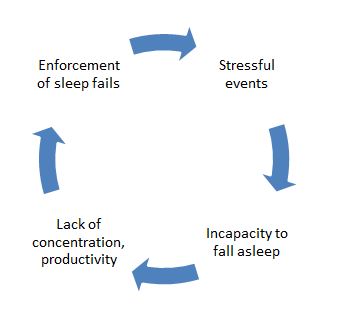
Causes
Causes of secondary Insomnia are mentioned above. Causes of acute primary Insomnia can be emotional or physical complaint, Stress (occupational or private), Illness, Environmental factors like noise, light, or extreme temperatures that impair the quality of sleep, Medications, Interferences in a normal sleep schedule. Causes of chronic primary Insomnia can be Depression or/and Anxiety, Chronic Stress, Pain or discomfort at night.
Often the feeling of tension can cause sleeplessness. Stressful events that have been occurred during the day and not been able to be broken down until the evening can prevent our sleep. A vicious circle starts as the person desires to sleep better on the next day and enforce his/her sleeps but achieves the contrary: a lack of sleep.
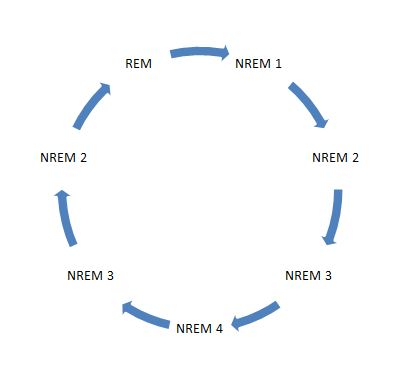 Another reason is the type of sleep. Indeed the profundity and length of a sleep characterizes its quality. Our sleep cycle distinguishes two main phases: The NREM (Non rapid eye movement) phase that has 4 stages going from light sleep to deep sleep and lasts for 90 minutes. This phase helps the body to regenerate. The REM (Rapid eye movement) phase, also known as the dream sleep, that helps to deal with events and emotions endured during the day. A person does not feel rested even if he/she slept 8 hours because the cycle was interrupted: When the person wakes up in the moment of the NREM deep sleep phase, he/she can feel not having got a good night’s rest. Also the regeneration of the body can be affected if the person is not able to reach the deep phase after going to sleep and instead wakes constantly up. The ideal cycle for a reposed sleep is shown in the diagram below:
Another reason is the type of sleep. Indeed the profundity and length of a sleep characterizes its quality. Our sleep cycle distinguishes two main phases: The NREM (Non rapid eye movement) phase that has 4 stages going from light sleep to deep sleep and lasts for 90 minutes. This phase helps the body to regenerate. The REM (Rapid eye movement) phase, also known as the dream sleep, that helps to deal with events and emotions endured during the day. A person does not feel rested even if he/she slept 8 hours because the cycle was interrupted: When the person wakes up in the moment of the NREM deep sleep phase, he/she can feel not having got a good night’s rest. Also the regeneration of the body can be affected if the person is not able to reach the deep phase after going to sleep and instead wakes constantly up. The ideal cycle for a reposed sleep is shown in the diagram below:Finally sleep disorders can also be caused by external disruptive factors: Too low room temperature, too flat/high or too soft/hard pillow, too hard/soft mattress, a ‘low breathable’ duvet are factors of sleep discomfort. Here are some recommendations: It is recommended to air the room before going to sleep. It is important to choose a Pillow that allows the spine to be perfectly aligned. You should use a medium-firm mattress to avoid muscles pressure and offer support to back, neck and legs. If possible, choose duvets made from natural materials (feather, silk, cotton) as they are more breathable and avoid the person to perspire, wake up and have the sleep disturbed.
Diagnostics
Polysomnography is a powerful tool to diagnose sleep disorders. Polysomnography is a comprehensive recording of physiological changes that occur during sleep such as brain waves, oxygen level in the blood, heart rate and breathing rate as well as eye and leg movement. It is used to diagnose or rule out many types of sleep disorders, including Narcolepsy, Restless legs movements, REM behavior, Parasomnias, somnambulism, epilepsy related disease, snoring and sleep apnoea. On the other hand, stress related or other psychiatric disturbances may cause sleep disorders or vice versa, just as inappropriate bedding.
For all these reasons it is of the utmost importance to analyse sleep and sleeping customs thoroughly in order to determine by aid of the neurologist the individually correct diagnosis and ensuing possibilities of treatment for sleep disorders. The sole application of sleeping drugs does not represent an ideal solution but may even be dangerous because it could lead to dependencies as unwanted side-effect.
How to Prepare for the Sleep Disorder Test
There are no major preparations necessary. The patient is advised not to take any sleep medicine or drink alcohol or caffeinated beverages prior to this test.
Risk factors of the Sleep Disorder Test
Polysomnography is a non invasive procedure. There is no risk, except maybe some skin irritation caused by the adhesive used to attach the sensors to the skin. It is therefore a fabulous procedure for children too.
Mechanism of the Sleep Disorder Test
Physiologic sensor leads are placed on the patient in order to record the following:
1. EEG (Electroencephalogram)
2. EOG (Electro-Occulogram)
3. EMG (Electromyogram)
4. ECG (Electrocardiogram)
5. Airflow (thermistor or thermocouple sensor)
6. Respiratory Effort (piezo crystal effort sensor)
7. Oxygen saturation (Pulse oximeter)Procedure of the Sleep Disorder Test
1. AT A SLEEP LABORATORY OR HOSPITAL
For the standard test, the patient - suffering from sleep disorders - comes to a sleep lab in the early evening, and over the next 1–2 hours is introduced to the setting and “wiring up” so that multiple channels of data can be recorded when he/she falls asleep. The sleep lab may be in a hospital, or in a center. A sleep technician should always be in attendance and is responsible for attaching the electrodes to the patient and monitoring the patient during the study. She must explain to the patient about the procedure to keep the patient relaxed throughout the night.
The sleep laboratory should be equipped with video cameras in the patient’s room, so that the patient can be recorded while sleeping. This allows the technician to review the tape at any time during the test and verify whether strange looking waveforms were caused by an actual arousal, a period of wake, or normal patient movements in bed.2. AT HOME
Nowadays, neurologists may carry out home studies to enhance patient comfort and reduce expenses, which is in the best interest of any patient. The patient is given thorough instructions as to how the screening tool is used. He will then use the equipment at home in his usual sleep surroundings and return it the next day. Most screening tools consist of an airflow measuring device (thermistor) and a blood oxygen monitoring device (pulse oximeter). They are small and easy to handle and produce excellent graphs and other results. At the German Neuroscience Center our neurologists follow this new path and provide patients - suffering from sleep disorders - with a tool they can easily apply at home rather than putting the patient into an awkward situation at the clinic because they realize that especially in Arabic countries with prayer times and similar rules to follow, it might be difficult for the patient to carry out a sleep study outside their homes.
The patient will sleep with the screening device for one to three nights, and then return the device to the neurologist. The neurologist will retrieve data from the device and can make assumptions based on the information given, for example, a series of drastic blood oxygen desaturations during night periods may indicate some form of respiratory event (apnea). At a minimum, the equipment will monitor the oxygen saturation.
Sleep Disorder Test SummaryPolysomnography (PSG) has proved to be a convincing tool for enhancing our understanding of sleep and sleep disorders. It is an essential diagnostic procedure to clarify the causes of sleep disorders thus enabling the neurologist to determine an appropriate form of treatment.
Ideally, and in accordance with international guidelines, sleep studies will be carried out by neurologists in close cooperation with an ENT specialist in such cases where first results point at a serious disease, as is standard at the German Neuroscience Center GNC.Evaluation of sleep disorders must be made more readily available to the hundreds of thousands of patients with sleep disorders who still lack diagnosis and treatment. Lack of sleep or permanently disturbed sleep will lead to reduced concentration and failing personal efficiency. This will not only gravely affect the patients’ private lives but also their daily working capacity. Sleep disorders, if not analyzed and left untreated, may lead to dangerous, even fatal, situations and social decline by, for instance, losing one’s job. Today, thanks to Polysomnography, nobody has to take such risks, since our neurologists, psychiatrists, and psychologists at the German Neuroscience Center know of many ways how to treat sleep disorders adequately after having analyzed and diagnosed the causes thoroughly.
Sleep Disorders, Treatment
There are very effective ways of treatment for sleep disorders these days. The problem is rather that patients are hesitant to search professional help. Thus a vicious circle could start where the sufferer is already afraid of going to bed. Obviously then it will be very difficult to fall asleep. If you are suffering from sleep disorders, you know what we are talking about. Specialists are using a combination of these scientifically proven treatment options for insomnia: Sleep hygiene, stimulus control, relaxation techniques, sleep restriction therapy, cognitive behavioural therapy and medications.
We would like to deliver one of these techniques to your doorstep or rather in your bedroom. Stimulus control therapy. It’s very effective and successfully used since more than 30 years. It sounds easy but it’s not. The pivotal point is your willpower to maintain these rules. It is actual work. If you don’t manage it alone, a psychologist might help you.
Rules of stimulus control therapy (Bootzin, 1980)
- Only go to bed when sleepy. Bear in mind being sleepy is not the same thing as being tired. It is important to be aware of this difference.
- Use the bed only for sleep and sexual activity. Do not engage in sleep-incompatible activity in bed such as eating snacks, watching TV or working.
- If after about 10 minutes you are unable to fall asleep or awaken, leave the bed and go to another room. Then return to bed and repeat as often as necessary until you do fall asleep. It is important to not watch the clock while doing this. It is your subjective estimate of time that is important.
- Keep a regular morning rise time no matter how much sleep you got the night before. This will help regularize the circadian (24 hour) schedule and if you don't sleep well one night, the drive to sleep will be higher the following night.
- Avoid napping. This prevents reducing sleep drive earlier in the day that can make it harder to fall asleep at night.
Why is it working? Psychologists call it conditioning. Conditioning is a type of learning that had a major influence on the school of thought in psychology known as behaviourism. Wrong conditioning is a major problem that occurs in chronic insomnia. If you repeatedly toss and turn in your bed for hours on end, your body will eventually learn to associate your bed with stress and being awake. As a result, your bedroom will actually cause you to stay awake. The points above are trying to address this problem and to re-teach your body to associate your bed with healthy sleep. Keep in mind that it takes time and effort to make it work. Like any other form of learning. However, if this is not sufficient a combination therapy might be the right thing for you. This could include sleep hygiene, relaxation techniques, sleep restriction therapy, cognitive behavioural therapy and medication.
Insomnia? Just popping sleeping pills? Bad idea! You should…
Some more tips:
1. Sport and relaxation techniques such as yoga help to get a healthy sleep. It is beneficial to practice them outdoor to get fresh air. However avoid doing sport in the evening or before going to bed, as this would stimulate the body and retard sleep.
2. Do not have heavy meal or stimulating drinks such as coffee, soda or alcohol before going to sleep. Nicotine can also lead to disquietness.
3. Try to relax and unwind before sleep time, switch off from the day, listen to soft music or read light readings. If you cannot stop the flow of stressful thoughts, clean your head by writing your thoughts/do to list/etc. down on a paper, and put the notice in a drawer. This helps to ‘exteriorize’ and ‘lock away’ your thoughts.
4. Before going to bed do not watch animated movies and news or read exciting books.
5. The bedroom should be associated to calmness and tranquility. It is recommended not to have a TV in the bedroom as it is a persistent stimulus.
6. Reduce external disturbing factors such as light or noise.
7. If you are not able to fall asleep eat products rich in magnesium. The best snack would be warm milk with honey and banana.
8. The smell of essential oils (Lavender, Balm or Sandal-wood) appeases the body and enhances sleepiness.
9. If insomnia remains, it is recommended to consult a psychologist who will apply techniques of cognitive behavior therapy. (Cognitive therapy, sleep restrictions, relaxation).
1o. When physical or neurological factors cause sleep disorders, it is imperative to consult a doctor. It is helpful to fill in a ‘sleep diary’ in which you mention bed and wake up time, activities done and food eaten during the day and thoughts or situation that have prevent you to sleep. This diary would provide support to detect the causes of the disorder.
Did You Know?
… that we spend one third of our lifetime sleeping.
…that a person’s body is programmed twice a day to sleepiness: between midnight and 7 am and between 1 and 4 pm.
…that we spend 20-25% of our time dreaming during our sleep.
…that Einstein needed 10-11 hours of sleep and Benjamin Franklin only 4 hours per night!
References:
1. Collop NA, Anderson WM, Boehlecke B, et al. Clinical guidelines for the use of unattended portable monitors in the diagnosis of obstructive sleep apnea in adult patients. Portable Monitoring Task Force of the American Academy of Sleep Medicine. J Clin Sleep Med . 2007;3:737-747.
2. Personal communication: Michael E. Garrison RSPGT, Supervisor Sleep Disorders Center KUMC.
3. Rechtschaffen, Allan. Kales, Anthony. A Manual of Standardized Terminology, Techniques and Scoring System for Sleep Stages of Human Subjects. Brain Information Service/Brain Research Institute. UCLA Los Angeles, CA. 1986.
4. McDonough, James T. Stedman’s Concise Medical Dictionary. 2nd edition. Williams and Wilkins Publishers. Baltimore, MD. 1994.
5.Sheldon SH, Spire J-P, Levy HB. Pediatric Sleep Medicine. W.B. Saunders, Co. Philadelphia, PA. 1992.
6. G. Hayak E. Ruther, Insomnie Schalffosigkeit, 1995.© GNC, German Neuroscience Center Dubai (Neurology, Psychiatry, Psychology, Counseling, Dubai, UAE)
Somatoform disorder
Somatoform Disorders
 Somatoform disorders are defined as somatic (bodily) symptoms without a sufficient somatic (bodily) cause. Only after somatic causes are ruled out, psychological factors can be taken into consideration. The presentation of the symptoms is the same, regardless if they are caused by somatic or psychological factors. A good example is common back pain. It can be caused by a pinched nerve as a somatic cause. The exact same pain can be cause by psychological factors, too. For most people this seems to be hard to believe. However, somatoform disorders are among the most common psychiatric disorders and occur in 10 to 15% of primary care patients.
Somatoform disorders are defined as somatic (bodily) symptoms without a sufficient somatic (bodily) cause. Only after somatic causes are ruled out, psychological factors can be taken into consideration. The presentation of the symptoms is the same, regardless if they are caused by somatic or psychological factors. A good example is common back pain. It can be caused by a pinched nerve as a somatic cause. The exact same pain can be cause by psychological factors, too. For most people this seems to be hard to believe. However, somatoform disorders are among the most common psychiatric disorders and occur in 10 to 15% of primary care patients.Somatoform disorders can cause almost all kind of symptoms. From pain over irritable bowel syndrome up to the fear of a brain tumor. As it is very natural to believe in a somatic reason, patients tent to undergo various medical investigations – even unnecessary surgeries. Sometimes patients are searching for a reason that explains the symptoms for years. They are consulting doctors frequently, which is called “doctor hopping” and often turn to alternative medicine. This kind of behavior expresses the enormous pressure these patients are under.
It is important to understand that these patients are ill, they will have pains, functional disorders or likewise. People with somatoform disorders are not faking their symptoms and their symptoms can significantly affect daily functioning. Their pain often has a dramatic impact of work, relationships, and other activities.
Types and Symptoms
1. Somatization disorder / Somatic Symptom Disorder
This type of somatoform disorder includes symptoms such as pain, neurologic problems, sexual problems, gynecological, cardiologic and gastrointestinal complaints. Patients often have a long history of medical problems but never a diagnosis that could really explain all their symptoms.
2. Undifferentiated somatoform disorder
One speaks of an undifferentiated somatoform disorder if the patient has one or more physical complaints of unexplained symptoms for at least six months.
3. Hypochondriasis
If a patient is concerned about having a serious disease and believes that minor complaints are signs of very serious medical problems he is suffering from this type of somatoform disorders.
4. Conversion disorder
In this type the patient has neurological symptoms such as paralysis, blindness, hearing loss or a loss of sensation or numbness without any medical cause.
5. Pain disorder
Patients with pain disorder typically experience pain that started with a psychological stress or trauma such as chronic headache after a stressful life event.
Diagnosis
Finding the diagnosis can be difficult and time consuming. A comprehensive medical examination including laboratory work and radiologic scans is needed to determine possible causes of the symptoms. It is very important to not overlook any somatic (bodily) cause. On the other side the patient shall be protected from unnecessary medical investigations and surgeries. If the examination does not reveal a clear source of the pain a somatoform disorder could be considered.
If you're unable to know what your mental health concern is, we can help you with that using our top Neurology Doctor, Psychiatry Doctor, and Psychology doctor's help.
Treatment
A strong doctor-patient relationship plays a key role in the effective treatment of somatoform disorders. For the patient it is important to understand that treating a somatoform disorder doesn’t mean neglecting the possibility of a somatic cause. It is not an either or decision the patient has to make. Treating a somatoform disorder correctly is rather an addition to the attempts the patient did so far. The doctor will evaluate all performed procedures and decide with the patient which further investigations are necessary and which ones are not. Patient and doctor together will develop a concept that takes all factors influencing the disease in consideration. These factors can be very different from patient to patient. Depending on this, different forms of treatment are effective. Cognitive behavioral therapy is used since it focuses on correcting distorted thoughts, unrealistic beliefs and behaviors that prompt health anxiety. The focus is rather on the improvement of daily functioning then on managing symptoms. Stress reduction is often an important part of getting better. Antidepressant medications can support the psychotherapy. Moreover, Support Groups can be helpful as well as stress reduction exercises, physical therapy and massage. The doctor will develop an individual treatment plan for each patient.
Trauma
Trauma, in its various forms, can have a profound impact on an individual's physical, emotional, and psychological well-being. Whether stemming from accidents, violence, or other distressing events, trauma can lead to a range of symptoms that may affect a person's quality of life. The German Neuroscience Center (GNC) in Dubai stands as a beacon of hope and healing, offering cutting-edge treatments and compassionate care to help individuals overcome trauma and embark on a journey towards recovery.Signs and Symptoms of Trauma
Trauma can manifest in a multitude of ways, with symptoms varying depending on the severity and nature of the traumatic event. Common signs of trauma include:- Re-experiencing: Flashbacks, nightmares, and intrusive thoughts about the traumatic event.
- Avoidance: Avoidance of triggers associated with the trauma, leading to withdrawal from people, places, or activities.
- Hyperarousal: Heightened alertness, irritability, difficulty concentrating, and an exaggerated startle response.
- Emotional Disturbances: Intense feelings of guilt, shame, anger, and sadness that may persist long after the event.
- Physical Symptoms: Headaches, muscle tension, fatigue, and disrupted sleep patterns.
Risk Factors for Trauma
Certain factors can increase an individual's vulnerability to experiencing trauma. These risk factors include:- Previous Trauma: A history of prior traumatic experiences can make individuals more susceptible to subsequent trauma.
- Lack of Support: Limited social support systems and isolation can magnify the impact of trauma.
- Personal Resilience: Some individuals may possess greater resilience, allowing them to cope more effectively with traumatic events.
- Exposure to Violence: Frequent exposure to violence, either as a victim or witness, can heighten the risk of trauma.
- Preexisting Mental Health Conditions: Individuals with preexisting anxiety, depression, or other mental health disorders may be more prone to trauma-related effects.
Causes and Diagnostics of Trauma
Trauma can arise from a range of events, such as accidents, natural disasters, interpersonal violence, and medical procedures. Diagnosing trauma involves a comprehensive assessment that considers the patient's history, symptoms, and emotional responses. The experienced clinicians at GNC employ state-of-the-art diagnostic techniques, including psychological evaluations and neuroimaging, to accurately assess the impact of trauma on an individual's mental and physical health.Trauma Treatments at German Neuroscience Center Dubai
The German Neuroscience Center in Dubai is renowned for its holistic approach to trauma treatment, offering a wide array of evidence-based interventions tailored to the unique needs of each patient. These include:- Psychotherapy: Individual and group therapies such as Cognitive Behavioral Therapy (CBT) and Eye Movement Desensitization and Reprocessing (EMDR) to address trauma-related symptoms and promote healing.
- Medication: In cases where symptoms are severe, targeted medications can be prescribed to alleviate anxiety, depression, and other distressing symptoms.
- Mind-Body Techniques: Practices like yoga, meditation, and deep breathing can help regulate the body's stress response and promote emotional well-being.
- Neurofeedback: Cutting-edge neurofeedback techniques aim to retrain brain patterns, facilitating emotional regulation and symptom reduction.
- Art and Expressive Therapies: Creative outlets can provide a means of processing trauma when words fall short.
Why Choose German Neuroscience Center Dubai?
The German Neuroscience Center Dubai stands as a beacon of hope and healing for individuals seeking comprehensive trauma treatment. With a team of internationally renowned experts, advanced diagnostic tools, and a patient-centric approach, GNC offers a safe and supportive environment for those on their journey to recovery. The center's commitment to excellence, innovation, and personalized care sets it apart as the premier destination for trauma treatment in the region.Conclusion
Trauma's effects can be far-reaching, impacting every facet of an individual's life. However, with the comprehensive and compassionate care provided by the German Neuroscience Center Dubai, healing is within reach. From cutting-edge treatments to a commitment to patient well-being, GNC stands as a beacon of hope, guiding individuals towards a brighter future where trauma's grip is loosened, and life's joys can once again be embracedTraumatic Brain Injury (TBI)
Traumatic brain injury (TBI) is a consequence of head injury in which a blow to the head results in damage to the brain due to stretch forces. TBI is the leading cause of death in North America for people below 45 years. The UAE has a comparably young population which makes TBI a very common and serious disease.
Many survivors live with significant disabilities, resulting in major socioeconomic burden as well. In 2000, the economic impact of TBI in the US was estimated to be $9.2 billion in lifetime medical costs and $51.2 billion in productivity losses.
Symptoms are often mild and hard to detect. It needs a trained specialist to diagnose and most importantly treat the condition. If treated adequately TBI has very good prognosis.
Causes
• Motor vehicle accidents
• Sport Injuries
• Falls
• Violence
• Military combatSymptoms
Brain injury is a frequently misunderstood injury. Numerous invisible residual complaints are labelled as 'psychological' and are not well understood. A major complaint of brain injury is fatigue and overstimulation.
Overstimulation
We live in a society that is very fast, with lots of stimuli to be processed at a high speed. When someone experiences overstimulation it is harder for them to process stimuli, sounds are perceived as louder and light as brighter. Ambient noise is perceived as irritating, normal sunlight is harder to endure and one gets easily overwhelmed by crowds and lots of movements in their surrounding.
Fatigue
Due to the quick onset of fatigue it can be difficult to go to birthday parties, to go grocery shopping and to participate in social activities. The fatigue causes disturbances in thinking processes and limits the entire functioning. After reading a text, one can already be so tired that one must rest for a period to recover from the mental effort. In particular, the reading of displays (smartphone, computer, tablet) can be highly discomforting to patients who experience brain injury. In addition to the fatigue and overstimulation one notices to have more trouble remembering and concentrating. Memory and concentration becomes harder when fatigue increases.
Secondary Symptoms
When one experiences symptoms but keeps on functioning beyond their own capacity, people can develop secondary complaints. Overstimulation of the brain cannot be compared to overstimulation of the body. The body has, for example, pain signals as a warning signal. The brains gives totally different warning signals like overstimulation by light, noise or crowds, having difficulty processing stimuli, more problems with thinking (concentration and memory) and fatigue. Many people do not recognize these alarm signals, or are not adequately dealing with them and are likely to push through their complaints. The functioning outside their own capacity will further increase the complaints and ultimately exhaustion will occur. Not being able to function in the way as is desired by the patient, the patient can also develop emotional reactions which are often characterized by feelings of powerlessness and frustration. Misunderstood injury thus consists of fatigue, rapidly becoming overstimulated, experiencing a decline in performance and emotional responses.
Misdiagnosing Traumatic Brain Injuries
Brain injury patients are often misdiagnosed or not diagnosed at all. As most professionals are not specialized in diagnosing TBI, the patients hear often “there is nothing wrong”, even if they are suffering from symptoms. Or their symptoms are evaluated as “only psychological”. Not treating TBI adequately will worsen symptoms. This described process is resulting in a major socioeconomic burden (US: $9.2 billion in lifetime medical costs and $51.2 billion in productivity losses).
Diagnosis
Neuropsychological assessment is needed to get a good impression of the 'invisible' residual symptoms and how to cope with them. The neuropsychological examination is used to assess the extent of (mental) energy loss, fatigue, cognitive - / emotional changes and the impact of pain sensations.
At the start of the counseling / therapy an extended interview (anamnesis) with the patient is performed. A broad range of issues are discussed, such as what happened, what are the symptoms, has it been a breaking point in the health perception, which conditions worsen symptoms or affect it. Furthermore, we look at (medical) history, education, type of work, hobbies, social life and how complaints are limiting it. A neuropsychological examination is carried out and on the basis of the results an appropriate treatment plan is suggested. If there is not enough information available, the expertise of many other disciplines can be consulted (neurologists, internists, psychiatrists, etc.).
With this information and understanding, it is possible to establish an adequate treatment involving persons with brain injuries to understand the actual limitations and how to adapt to it.
Treatment
It is important to know that patients themselves often do not have a good understanding of the limitation of their symptoms and complaints, and the patient is driven to perform at pre-morbid level. Recovering from brain damage is a complex process that a patient has to go through with the help of a professional. It is necessary that one acquires knowledge in the presentation of symptoms and also get advice how to deal with it. A brain injury is essentially a neuropsychological phenomenon.
Neuropsychological Rehabilitation
In the next phase, the affected cognitive functions are reactivated and a medical fitness program is used to improve the energy level and reduce pain levels.
Often, the treatment consists of guidance of a clinical neuropsychologist which will provide insight into the complaints and why these occur. Adjustments are taught and exercise / rest schedules are discussed. During the same period, patients will follow medical fitness programs and a cognitrain program. This followed by rest periods. If pain symptoms stay apparent, a neurologist or pain doctor (anaesthesist) is considered. Often the pain sensations consist of pain in the neck and shoulders which also develops into headaches. The progress of each patient is discussed daily and programs are adapted to this feedback. The goal is to become a well- balanced individual again.
To achieve this, the main focus is on personal attention. Our view is that every person is like a fingerprint, completely unique. There is no standard protocol used to provide treatment, as each person has their own way of reacting to all aspects relating to brain injury.
The program usually has a duration of three months and the maximum group size is 12 people. The main goal of a small group is to build a personal relationship with each participant in the program.
If you think that you want to fix something else related to your mental health. GNC Dubai is providing one of the best psychiatrists in Dubai, psychologists in Dubai and psychotherapists in Dubai who can help you find the core reason and in fixing it.
Common Misconception
Often there is a misconception that the complaints of (mild) brain injury will resolve after some time. This natural recovery can only occur when conditions are optimal. One needs to perform the right activities during the recovery period in order to optimize the recovery. It should be noted that even with an optimal recovery period there may be residual complaints!
© GNC, German Neuroscience Center Dubai (Neurology, Psychiatry, Psychology, Counseling, Dubai, UAE)
